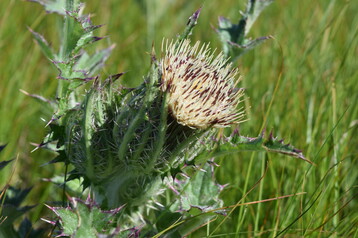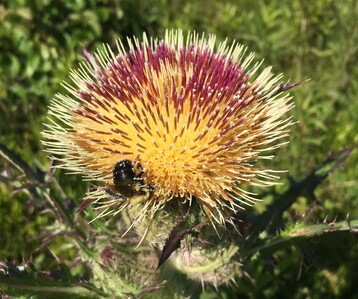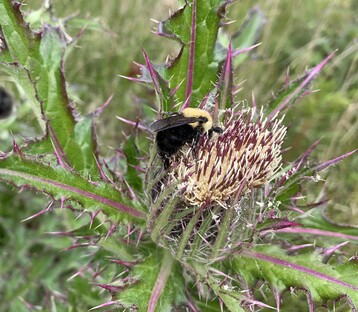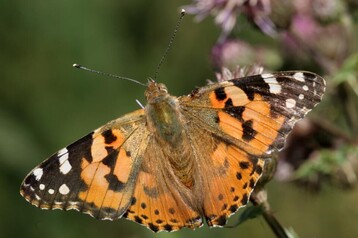Current Nature: Yellow Thistle, A Hotspot Of Biodiversity
Seth Engelbourg, Director of Education And Interpretation, Linda Loring Nature Foundation •

Despite their unique adaptations, thistles are often misunderstood and underappreciated; cast off as spiky weeds that grow rampant and are impossible to maintain. Although we have several species of non-native thistle on Nantucket that may outcompete other plants, our native thistles species are massively important to our ecosystems and promote biodiversity.
In particular, I want to highlight Cirsium horridulum, commonly known as Yellow Thistle or sometimes by its more fun rhyming name; Bristle Thistle. Yellow Thistle is a densely hairy and spiny plant. The flowers on this thistle are beautiful; large yellow blossoms with reddish tips. They also are a biodiversity hotspot; pollinators of all shapes and sizes visit the flowers, including bees and many species of butterflies. Yellow Thistle also serves as the host plant for the Painted Lady butterfly which is found on Nantucket. When the flowers go to seed, they become a favorite food source for many birds, especially the American Goldfinch, a bright yellow and beloved native bird species.

Yellow Thistle thrives in Atlantic Coastal Plain habitats; it is generally found in upland areas such as our Sandplain Grasslands, but is also sometimes found in wetlands. Across much of New England it is rare, threats to it are not widely documented but human development, invasive species, and accidental removal due to confusion with non-native thistles likely play a role. Yellow Thistle has official endangered species status in Rhode Island (threatened), Connecticut (endangered), New Hampshire (endangered), and Maine (potentially extirpated). Luckily for us, it is not officially listed in Massachusetts; however, it is considered a watch list species. What this means is that the state believes there is a potential for the species to become endangered in the future and wants to collect more information on its range and population density to evaluate its success. As part of this effort, Linda Loring Nature Foundation staff and volunteers have been monitoring the populations found on our property. For the past several weeks our team has been going out in the field to search for this plant, document its locations via GPS, and record other data. Ultimately, once we have a more complete picture of where Yellow Thistle is found on our property, we will submit that data to MassWildlife’s Natural Heritage and Endangered Species Program, the state agency tasked with reviewing and regulating rare species.

The peak bloom time for Yellow Thistle is around June 15th each year; however, the flower heads stay visible later into the summer. Paired with its spiny leaves, it can be an easy species to identify once you know what you are looking for. If you are out walking on trails or exploring natural areas this summer and think you've seen one, please consider submitting it to iNaturalist, or better yet, participate in the 2025 Nantucket BioBlitz by reporting your observation during the blitz period from July 25th to August 8th. I hope you learned something new and appreciate the important role Yellow Thistles play in Nantucket’s ecosystems.
Stay tuned for more editions of Current Nature, a bi-weekly column featuring seasonal topics, natural history information, and advice on the outdoors from the staff at the Linda Loring Nature Foundation.
